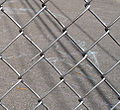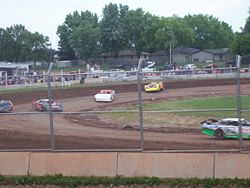
Chain link fencing
Encyclopedia

Woven
A woven is a cloth formed by weaving. It only stretches in the bias directions , unless the threads are elastic. Woven cloth usually frays at the edges, unless measures are taken to counter this, such as the use of pinking shears or hemming.Woven fabrics are worked on a loom and made of many...
fence
Fence
A fence is a freestanding structure designed to restrict or prevent movement across a boundary. It is generally distinguished from a wall by the lightness of its construction: a wall is usually restricted to such barriers made from solid brick or concrete, blocking vision as well as passage .Fences...
usually made from galvanized
Galvanization
Galvanization is the process of applying a protective zinc coating to steel or iron, in order to prevent rusting. The term is derived from the name of Italian scientist Luigi Galvani....
or LLDPE-coated steel
Steel
Steel is an alloy that consists mostly of iron and has a carbon content between 0.2% and 2.1% by weight, depending on the grade. Carbon is the most common alloying material for iron, but various other alloying elements are used, such as manganese, chromium, vanadium, and tungsten...
wire. The wire
Wire
A wire is a single, usually cylindrical, flexible strand or rod of metal. Wires are used to bear mechanical loads and to carry electricity and telecommunications signals. Wire is commonly formed by drawing the metal through a hole in a die or draw plate. Standard sizes are determined by various...
s run vertically and are bent into a zig-zag pattern so that each "zig" hooks with the wire immediately on one side and each "zag" with the wire immediately on the other. This forms the characteristic diamond
Polyiamond
A polyiamond is a polyform whose base form is an equilateral triangle. The word polyiamond is a back-formation from diamond, because this word is often used to describe the shape of a pair of equilateral triangles placed base to base, and the initial "di-" looked like a Greek prefix meaning...
pattern seen in this type of fence.
Sizes and uses
In the United StatesUnited States
The United States of America is a federal constitutional republic comprising fifty states and a federal district...
, fencing usually comes in 20 rod and 50 ft rolls which can be joined by "unscrewing" one of the end wires and then "screwing" it back in so that it hooks both pieces. Common heights include 3 ft, 3 ft 6 in, 4 ft, 5 ft, 6 ft, 7 ft, 8 ft, 10 ft, and 12 ft, though almost any height is possible. Common mesh gauges are 9, 11, and 11.5.
For tennis courts and ball parks the most popular height is 10 ft.
The popularity of chain-link fence is due to its relatively low cost and ease of installation. A further advantage is that due to the open weave, chain-link fences are transparent, and do not obscure sunlight from either side of the fence. If a semi-opaque fence is desired, this can be achieved by the insertion of slats into the mesh.
Installation
The installation of chain-link fence involves setting posts into the ground and attaching the fence to them. The posts may be steel tubing, timber or concrete and may be driven into the ground or set in concrete (preferably both). End, corner or gate posts, commonly referred to as 'terminal posts', must either be set in concrete footing or otherwise anchored to prevent leaning under the tension of a stretched fence. Posts set between the terminal posts are called line posts and are set in concrete footings (or in some locations driven in place) at intervals not to exceed 10 feet. The fence is attached at one end, stretched, and attached at the other, the excess being easily removed by "unscrewing" a wire. Finally it is tied to the line posts with aluminum wire. In many cases a bottom tension wire, sometimes referred to as coil wire, may be stretched between terminal posts to help minimize the in and out movement that occurs at the bottom of the chain-link mesh between posts. Once stretched, this wire should be secured to the line posts and the chain-link mesh "hog ringed" to the tension wire 2' on center. The installation of this wire is generally done prior to the installation of the chain-link mesh.Development of chain-link fencing

Norwich
Norwich is a city in England. It is the regional administrative centre and county town of Norfolk. During the 11th century, Norwich was the largest city in England after London, and one of the most important places in the kingdom...
to produce chain-link fencing by machine. The process was developed by Charles Barnard in 1844 based on cloth weaving machines (up until that time Norwich had a long history of cloth manufacture).
Anchor Fence (established in 1891) was the first US company to manufacture chain-link fencing by machines using equipment imported from Belgium.
Manufacturing
The manufacturing of chain-link fencing is called weavingWeaving
Weaving is a method of fabric production in which two distinct sets of yarns or threads are interlaced at right angles to form a fabric or cloth. The other methods are knitting, lace making and felting. The longitudinal threads are called the warp and the lateral threads are the weft or filling...
. A metal wire
Wire
A wire is a single, usually cylindrical, flexible strand or rod of metal. Wires are used to bear mechanical loads and to carry electricity and telecommunications signals. Wire is commonly formed by drawing the metal through a hole in a die or draw plate. Standard sizes are determined by various...
, often galvanized to reduce corrosion
Corrosion
Corrosion is the disintegration of an engineered material into its constituent atoms due to chemical reactions with its surroundings. In the most common use of the word, this means electrochemical oxidation of metals in reaction with an oxidant such as oxygen...
, is pulled along a rotating long and flat blade
Blade
A blade is that portion of a tool, weapon, or machine with a cutting edge and/or a pointed tip that is designed to cut and/or puncture, stab, slash, chop, slice, thrust, or scrape animate or inanimate surfaces or materials...
, thus creating a somewhat flattened spiral
Helix
A helix is a type of smooth space curve, i.e. a curve in three-dimensional space. It has the property that the tangent line at any point makes a constant angle with a fixed line called the axis. Examples of helixes are coil springs and the handrails of spiral staircases. A "filled-in" helix – for...
. The spiral continues to rotate past the blade and winds its way through the previous spiral that is already part of the fence. When the spiral reaches the far end of the fence, the spiral is cut near the blade. Next, the spiral is pressed flat and the entire fence is moved up, ready for the next cycle. The end of every second spiral overlap the end of every first spiral. The machine clamps both ends and gives them a few twists. This makes the links permanent.
An improved version of the weaving machine winds two wires a round the blade at once, thus creating a double helix. One of the spirals is woven through the last spiral that is already part of the fence. This improvement allows the process to advance twice as fast.
Notable uses

- Used to notable effect in the Gehry ResidenceGehry ResidenceThe Gehry Residence is Frank Gehry's own house. It was originally an extension, designed by Gehry built around an existing house. It makes use of unconventional materials, such as chain link fence and corrugated steel....
by Frank GehryFrank GehryFrank Owen Gehry, is a Canadian American Pritzker Prize-winning architect based in Los Angeles, California.His buildings, including his private residence, have become tourist attractions... - Wrestling steel cage matches
- Backstops used in baseball and softball fields
- Before the advent of gravel trapRun-off areaA run-off area is an area on a racetrack for racer safety. Run-off areas are usually located along a race course where racers are most likely to unintentionally depart from the prescribed course. It is also known as a gravel trap or, informally, kitty litter – see glossary of motorsport terms...
in the later half of the 1980s, chain-link fencing was used as catch fences in racetracks to slow out-of-control cars down before they impact barriers. In the 2000s they continued to be used at American dirt tracksDirt track racingDirt track racing is a type of auto racing performed on oval tracks. It began in the United States before World War I and became widespread during the 1920s and 30s. Two different types of racecars predominated—open wheel racers in the Northeast and West and stock cars in the South...
. - Many parks in LondonLondonLondon is the capital city of :England and the :United Kingdom, the largest metropolitan area in the United Kingdom, and the largest urban zone in the European Union by most measures. Located on the River Thames, London has been a major settlement for two millennia, its history going back to its...
were replaced with chain-link fencing during the Second world war when the original iron and steel railings were removed for the war effortWar effortIn politics and military planning, a war effort refers to a coordinated mobilization of society's resources—both industrial and human—towards the support of a military force...
(Though many are now being replaced).

